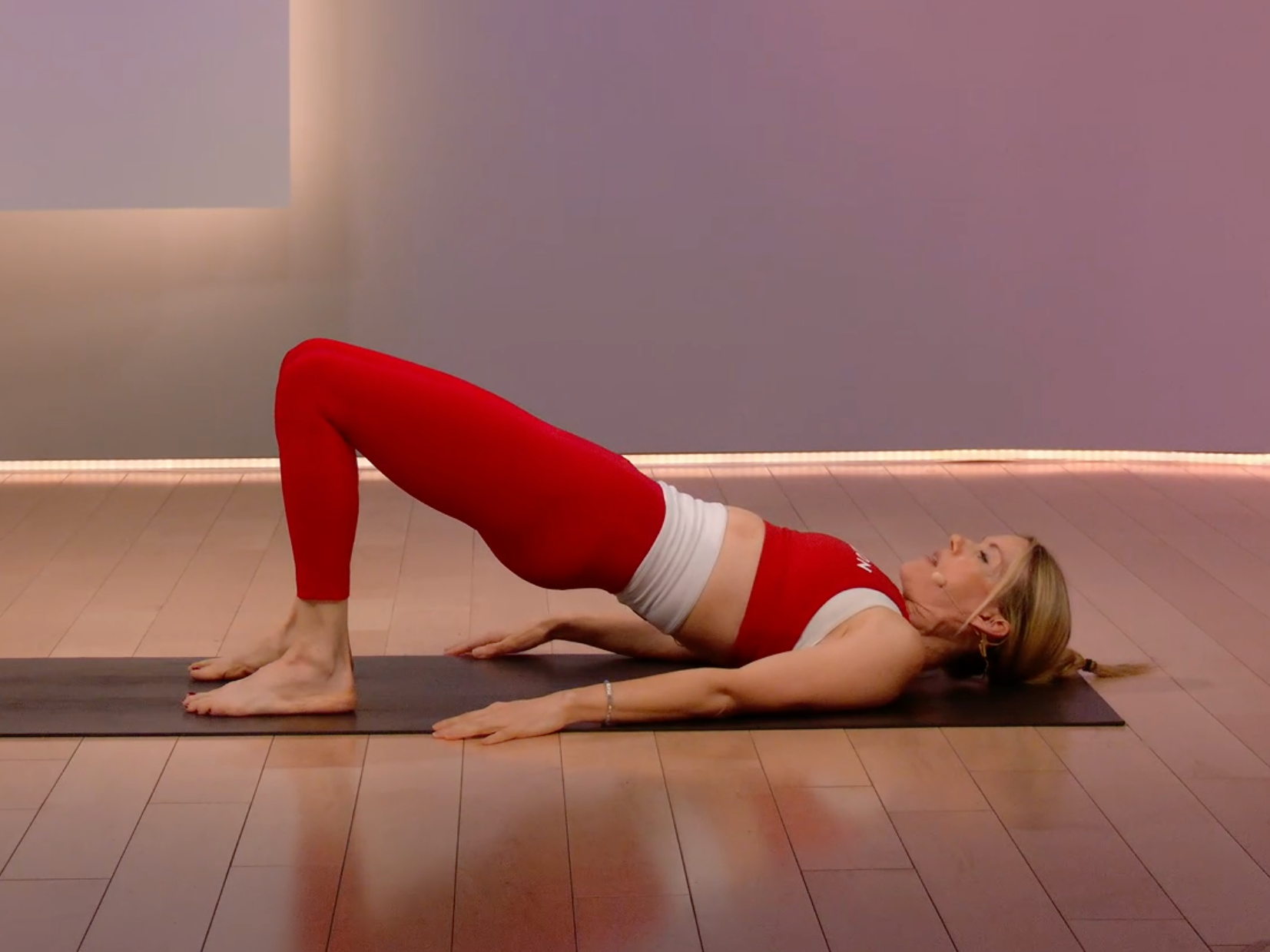
Prostock-Studio/iStock/Getty Images Plus via Getty Images
A Step-By-Step Guide to Practicing Bridge Pose
Bridge is a pose found in many classes, and for good reason.
By Elizabeth Millard•
What Is Bridge Pose In Yoga?
Benefits of Bridge Pose
How to Do Bridge Pose
Common Mistakes to Avoid In Bridge Pose
How to Modify or Progress Bridge Pose
In many of Peloton's Yoga Classes, you may be cued to do Bridge Pose as part of a sequence done while lying on your back. Although it may seem like a simple pose—basically, you lift your hips with your feet planted firmly—there are nuances to keep in mind to make it more effective. Also, some modifications can make it either tougher or less challenging.
Let's take a look at Bridge Pose, including why it's done and what you can get out of the posture.
What Is Bridge Pose In Yoga?
It may not look much like an actual bridge, but this pose involves lifting the hips while you're lying on your mat, with shoulders and feet providing stability.
Typically, a pose like this (that's done on your back and involves recruiting different muscle groups) is done later in a yoga sequence—meaning after the standing poses and balance poses are completed. That way, your muscles are more warmed up and you can also focus more on stabilizing your shoulders in the group. However, that's not a standard rule—some classes may put Bridge Pose into an initial sequence, for example, as a way to fire up muscles you'll use later, says Peloton yoga instructor Kirra Michel.
"Typically, I sequence Bridge towards the end of class to ensure the spine, hips, and shoulders are warmed up," she notes. "Sometimes, though, I sequence a gentle, dynamic bridge at the beginning to help warm up the spine, glutes, and shoulders."
Benefits of Bridge Pose
Although it may look simple to an observer, Bridge Pose involves a combination of strength, mobility, focus, and endurance. Other major benefits include:
Extends the Spine
Lifting the hips in a way that's supported creates extension in the spine, says Kirra, adding that this is especially helpful for people who sit most of the day at work or school. For instance, Cedars-Sinai notes that sitting for prolonged periods can cause the spinal vertebrae to become compressed over time—which then increases the risk of back pain and slouching, making the problem worse. Regularly extending the spine can counteract this compression.
Stretches the Hip Flexors
Another danger of sitting too much is tightness in the hip flexors, Cedars-Sinai notes. These are the flexors in the front of your hips, and sitting can "shorten" them if you don't stretch. Over time, this can be another contributor to back pain as well as less mobility. For example, you may not be able to squat as deeply when you're exercising or even when you're picking something up off the floor. Bridge Pose helps you get in a position where you're stretching the hip flexors in a safe, effective way.
Engages the Glutes
Although your core muscles in the abdomen are an essential part of mobility, your glutes play a major role in how well they work, according to Mayo Clinic. The glutes provide stability, and help control movements in a way that builds strength, while also helping keep your spine in a neutral position. The advantages of this combination are profound: You get better balance, more power as you run or jump, and protection for your hip joints as you move.
Calms the Mind
Any pose where the head is below the heart is called an inversion. For example, standing in a Forward Fold where your head is hanging toward your feet, or doing a Headstand or Handstand. Bridge Pose offers this type of inversion in a more modest way, but it still brings the benefits of those poses, says Kirra. "Having your head below the heart calms the mind," she adds.
How to Do Bridge Pose
Here are the steps for a standard bridge pose:

Lie on your back with knees bent and feet flat on your mat or the floor, feet placed about hip-width apart.
Place arms at your side with palms down on the mat.
Walk feet in toward your glutes and then place them down again so all parts of the foot are on the mat.
Inhale deeply and lift your hips while pressing into your feet and keeping your knees parallel (not coming in toward each other or moving away from each other).
Keep your shoulders firmly planted on the ground and look up toward the ceiling so your neck stays in line with your spine. Don't lift your head.
Continue to press into your feet to keep your legs engaged and press your palms against the ground but try to keep your shoulders somewhat relaxed.
Hold the pose for five breaths, then lower the hips.
Common Mistakes to Avoid In Bridge Pose
Particularly if the pose is unfamiliar to you, it's easy to hold your breath, especially when your hips are raised. But this makes your muscles tense and can cause you to put too much tension into the shoulders, says Kirra. Another mistake is thinking the pose is not adaptable, even if you're feeling discomfort.
"Try not to be so rigid with it," she adds. "Give yourself permission to explore the shape in your body. For example, if having the feet at hip-width and parallel is hurting your knees or simply isn't comfortable, then step the feet wider or turn the feet out slightly."
Because Bridge Pose usually involves lifting the hips and holding, then bringing them back down and following with coming back into the pose, one mistake is to go too fast through multiple bridges, Kirra says. The spine needs a few seconds at least to reset and come into a neutral position after the challenge of the first Bridge Pose.
Another mistake to avoid: Turning the head from side to side. This is problematic because it puts pressure on the cervical spine, says Kirra. Even turning slightly to look around the room can increase muscle tension in the neck. Because of that, she suggests keeping the head and neck in alignment, looking upward (not at your knees or to the sides) and maintaining a natural curve in the neck.
How to Modify or Progress Bridge Pose
Like many poses in yoga, Bridge Pose can be modified to make it more challenging in a way that engages more muscles, or to turn the pose into a more restorative, easy pose. Here are some suggestions for both.
Modifications for an Easier Bridge Pose
If you find Bridge Pose to be too taxing, or feel like you can't get into the pose fully yet, try these modifications:
Squeeze a foam yoga block between the knees or thighs to keep your legs in alignment as you raise your hips.
Don't bring your hips up as high.
Support your Bridge by placing a block under your lower back after you've lifted your hips, making it into a passive rather than an active pose.
Modifications for a More Challenging Bridge Pose
If you're comfortable in regular Bridge Pose and you want to progress the pose to be more challenging, try these:
Clasp your hands on the mat underneath your lifted hips; this involves rolling each shoulder slightly under you while still keeping the top of the shoulders on the ground.
Extend one leg upwards and hold as your hips are lifted.
Try Bridge marches, which involves bringing one knee toward the chest at a time while keeping the glutes and hips lifted.
Play around with hamstring curls, which means sliding one heel out while hips are on the ground, then lift into Bridge, come back down, and slide the other heel out. Keep alternating as you lift up and down from Bridge Pose.
Progressing to Wheel Pose
One advantage to doing Bridge Pose regularly is that it will help you develop muscles that allow you to go into Wheel Pose safely. This pose involves lifting yourself fully off the mat upside down (so your belly and chest are facing the ceiling), anchored by only your feet and hands. "Because Bridge helps stretch and strengthen the thighs, hip muscles, core, and chest, you'll be more ready for Wheel," says Kirra.
Whether you're trying challenging modifications or just perfecting the standard Bridge so it feels comfortable in your body, you'll be working on boosting your mobility, flexibility, and strength, according to Kirra. And like all yoga poses, the more often you do Bridge Pose, the more practiced you'll feel when it comes up in your yoga classes.

Peloton App
Access thousands of classes with no equipment needed.
This content is for informational and educational purposes only and does not constitute individualized advice. It is not intended to replace professional medical evaluation, diagnosis, or treatment. Seek the advice of your physician for questions you may have regarding your health or a medical condition. If you are having a medical emergency, call your physician or 911 immediately.
Level up your inbox.
Subscribe for a weekly dose of fitness, plus the latest promos, launches, and events.
By providing your email address, you agree to receive marketing communications from Peloton.
For more about how we use your information, see our Privacy Policy.









